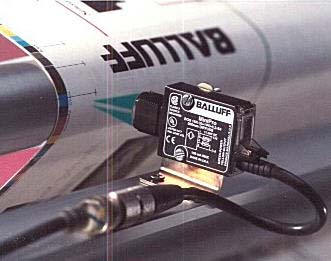Choosing the Right Sensor LED Color to Detect Color Marks
By Tom Rosenberg, Balluff, Inc.
Reliable color mark detection is a critical piece of the processing puzzle for printing, packaging, and marking industries. Pulse-modulated optical sensors are a popular choice for color mark detection because they are designed to ignore ambient light and respond only to their own light source. But since these sensors are available with a variety of LED light source colors, how do you know which color to choose for your application?
Imagine looking at a printed red mark on white stock. The red mark looks dark in contrast to the white paper. Now imagine placing a red transparent filter in front of your eyes while looking at the red mark. The mark now becomes difficult, if not impossible, to see. A sensor equipped with a red LED would have the same problem and, most probably, would not register the mark.

Sensor LEDs are available in several different colors and "shades" of colors, including visible red, green, white, and invisible infrared. The following guidelines will help determine the appropriate LED color for your color mark detection application.
Visible White
- Best overall choice for detecting printed registration marks on packaging material and for sorting colored objects
- Recommended for detecting dark colored objects in the proximity (diffuse) mode
- Invisible infrared (880 nm)
Best choice for most opaque sensing tasks
- Provides longest possible sensing range in either beam-make or beam-break sensing modes
- Best choice in hostile environments (able to penetrate lens contamination)
- Preferred for use with small, glass, fiber-optic light guides (do not use IR light with plastic fiber-optic light guides)
- Preferred when sensing dark colored objects in the proximity (diffuse) mode (i.e. black, blue, green, etc.)
- Useful in penetrating containers for verification of contents, also in detecting overlapped splices in dense materials
- Favors blue-colored objects
Visible Red (660 nm)
- Best choice for use with plastic fiber-optic light guides
- Useful when sensing translucent objects in proximity (beam-make) mode
- Useful when sensing transparent objects in fiber-optic retro-reflective (beam-break) mode
- Can be polarized for retro-reflective (beam-break) sensing to eliminate misreads on shiny objects
- Opposed fiber-optic light guides can be polarized for sensing some translucent containers
- Operates as red filter for color perception advantages
Green Light Source (550 nm)
- Useful in resolving printed registration marks in a wide variety of colors
- Useful in resolving red/pink objects from light-colored backgrounds
- Functions as green filter and is recommended for use in applications where the color green provides obvious color perception advantages
Blue Light Source (480 nm)
- Best choice for detecting translucent or transparent, plastic or glass objects in the retro-reflective (beam-break) mode
- Operates as blue filter for color perception advantages, i.e. resolving yellow vs white colored objects
Tom Rosenberg is sensors product line manager at Balluff Inc.
For more information: Balluff Inc., 8125 Holton Dr., Florence, KY 41042. Tel: 800-543-8390
Source: Purchasing Network.com, sister website to Medical Design Online.
